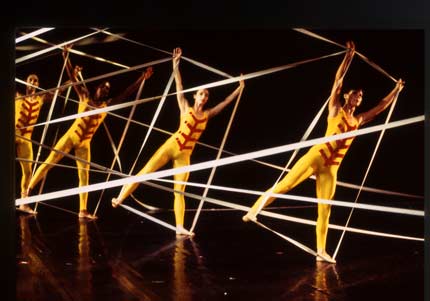Alwin Nikolais was the magician of dance, the forerunner of now wildly popular companies like Pilobolus and Momix and a pioneer in multimedia effects. From the 1950s to the 1990s his work was celebrated both in the United States and internationally (he was particularly popular in France), and his company continued to perform for several years after his death, in 1993.
In 1999, Murray Louis, Nikolais’s personal and professional partner of 40 years, disbanded the troupe, and since then his work has been little seen in New York. On Tuesday night at the Joyce Theater, the Alwin Nikolais Centennial program continued a celebration of his birth that began last week at the Abrons Arts Center at the Henry Street Settlement, where Nikolais first began to create work in 1948.

In 1999, Murray Louis, Nikolais’s personal and professional partner of 40 years, disbanded the troupe, and since then his work has been little seen in New York. On Tuesday night at the Joyce Theater, the Alwin Nikolais Centennial program continued a celebration of his birth that began last week at the Abrons Arts Center at the Henry Street Settlement, where Nikolais first began to create work in 1948.

For a whole generation of dancegoers it might now be hard to comprehend just how original Nikolais’s early experiments were, with their amalgams of bodies, light, sound and props. The evening began with Mr. Louis reading a proclamation from Mayor Michael R. Bloomberg explaining exactly why this was so, and proclaiming that Tuesday was Alwin Nikolais Day. (Not exactly a long-term commitment.)
The mayor’s note invoked Martha Graham as a contemporary, which probably made Nikolais pirouette in his grave, since his work emerged out of a firm rejection of the kinds of psychologically inclined dance dramas that Graham was creating in the 1940s. Like George Balanchine and Merce Cunningham, he turned toward pure form and abstraction and away from narrative and emotion.
But unlike Balanchine and Cunningham, Nikolais was interested in sleight-of-hand and eye, in visual illusion rather than the expansion of a dance vocabulary. And unlike those choreographers, he was a one-man band, inventing not just the movement, but the lighting and sound too.
In one of his best-known pieces, “Tensile Involvement” (1955), which opened Tuesday’s program, the dancers are tethered to long elastic bands and create cat’s cradles of crisscrossing lines as they run on and off the stage. In “Crucible” (1985) tiny wiggling forms, reflected by angled mirrors, grow into larger abstract shapes and finally into strange truncated beings, apparently floating in space. (That the dancers’ upper bodies are eventually revealed as naked also both prefigures a contemporary dance trend and suggests the hippie counterculture of the “Hair” era.)
Both of these dances, like the excerpts from “Liturgies” (1983), were meticulously staged by Mr. Louis and Alberto del Saz, a former Nikolais dancer, and were performed with exemplary precision by the Ririe-Woodbury Dance Company from Utah, the principal keeper of the Nikolais flame.
But for the sake of that flame they should all lay “Tower” (1968), from the longer “Vaudeville of the Elements,” to rest. Perhaps Nikolais’s original dancers could carry off the hectic shouting and posturing that “Tower” demands as its 10 dancers carry around metal frames that are eventually built
into said tower. But as it appears now, the performance by the suffering dancers is unconvincing; there is no dance interest, no visual suspense or drama. The wait for the tower to topple — you know it will — is excruciatingly dull. Nikolais, whose currency was wonder and magic, shouldn’t be remembered for this.
(This dance critical review is from The New York Times, By ROSLYN SULCASMAY, 5, 2010)
The mayor’s note invoked Martha Graham as a contemporary, which probably made Nikolais pirouette in his grave, since his work emerged out of a firm rejection of the kinds of psychologically inclined dance dramas that Graham was creating in the 1940s. Like George Balanchine and Merce Cunningham, he turned toward pure form and abstraction and away from narrative and emotion.
But unlike Balanchine and Cunningham, Nikolais was interested in sleight-of-hand and eye, in visual illusion rather than the expansion of a dance vocabulary. And unlike those choreographers, he was a one-man band, inventing not just the movement, but the lighting and sound too.
In one of his best-known pieces, “Tensile Involvement” (1955), which opened Tuesday’s program, the dancers are tethered to long elastic bands and create cat’s cradles of crisscrossing lines as they run on and off the stage. In “Crucible” (1985) tiny wiggling forms, reflected by angled mirrors, grow into larger abstract shapes and finally into strange truncated beings, apparently floating in space. (That the dancers’ upper bodies are eventually revealed as naked also both prefigures a contemporary dance trend and suggests the hippie counterculture of the “Hair” era.)
Both of these dances, like the excerpts from “Liturgies” (1983), were meticulously staged by Mr. Louis and Alberto del Saz, a former Nikolais dancer, and were performed with exemplary precision by the Ririe-Woodbury Dance Company from Utah, the principal keeper of the Nikolais flame.
But for the sake of that flame they should all lay “Tower” (1968), from the longer “Vaudeville of the Elements,” to rest. Perhaps Nikolais’s original dancers could carry off the hectic shouting and posturing that “Tower” demands as its 10 dancers carry around metal frames that are eventually built
into said tower. But as it appears now, the performance by the suffering dancers is unconvincing; there is no dance interest, no visual suspense or drama. The wait for the tower to topple — you know it will — is excruciatingly dull. Nikolais, whose currency was wonder and magic, shouldn’t be remembered for this.

(This dance critical review is from The New York Times, By ROSLYN SULCASMAY, 5, 2010)
No comments:
Post a Comment